Optimize Product Content On The Digital Shelf
Optimizing product content on the digital shelf is essential for your brand to win. How do you keep the overview? and where do you start optimizing?
Learn about ways to make your brand visible on Google Shopping, draw shoppers to your products, be brand-compliant and drive sales on the platform.
If your products are featured on Google Shopping, you've probably discovered that creating a solid brand presence is much more than simply listing your products and waiting for sales to roll in. In this blog, we'll take a look at ways to make your brand visible, draw shoppers to your products and be brand-compliant on the Google Shopping platform.
What we'll talk about in this blog:
Google Shopping is a Google service where shoppers search, compare and (in some countries directly on the platform) shop for physical products. The service is the start line for your potential customers when searching for products online via Google.
Google Shopping bots search across different online stores for the product being sought and display the results. Google Shopping results typically show up as thumbnail images that can display the product’s title, price, delivery info, features, the store or business name, (number of) seller(s), and ratings & reviews.
Product Ranking on Google Shopping is based on relevancy, advertiser bids, and the searchers' (previous) Google activities.
As a brand manufacturer, you can directly list products on Google Shopping. Ensure you include as much high-quality info as you can through a data feed in Google Merchant Center (and Google Manufacturer Center, but we'll touch on that later).
Certain product attributes such as your products' title, description, category, landing page link, image link, price, and availability are required. The more info you provide, the more relevant your listings and ads are going to be.
In principle, every webshop administrator can upload their product information to the Google Merchant Center. If resellers list your brands' products on Google Shopping, you lose a certain amount of control over how your products are being displayed. Keep reading to find out how you can be present on Google Shopping and at the same time get more control!
Googles' Comparison Shopping Engine (CSE) allows you to advertise products to potential customers and directly sell products on the platform in some countries. Google Shopping Ads make up 60% of all Google Ads clicks (source: Yotpo).
Promoting your products to buyers who search for what you offer on Google can help increase sales, and your brand visibility and draw new customers to your webshop.
Sponsored Google Shopping results are found at the top of a Google results page.
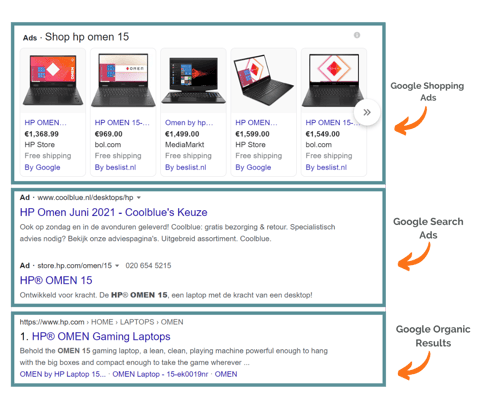
If you want to advertise your products for sale on Google (after you've listed your products via the Google Merchant Center), you:
Who doesn’t want more value for money? Use the 'Merchant Promotions' option in Merchant Center to highlight the following promotions for your products:
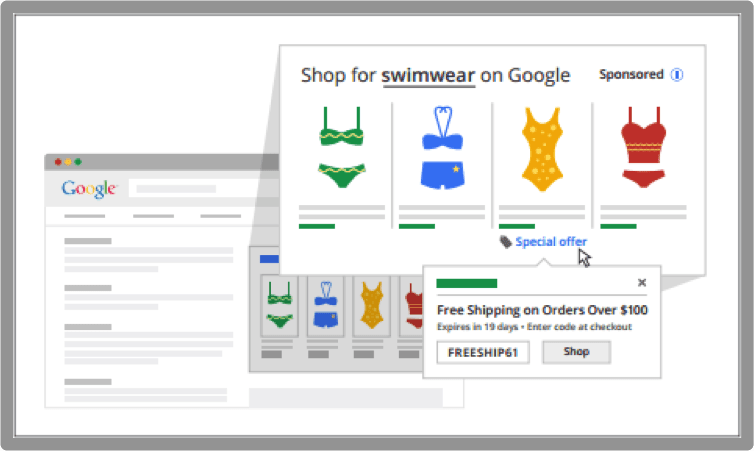
Promotions display as a clickable note that states 'special offer'. When you click, more details about the promotion appear. Adding promotions is free, but any cost-per-click rates still apply. Promotions are available in the following countries: Australia, France, Germany, India, the UK, Canada, and the US. You must have a Google Merchant Center account with an active products feed to add promotions.
As a manufacturer selling online, you want:
The Google Manufacturer Center is intended to let brand manufacturers correctly represent products to shoppers on Google Shopping and other Google services. The Manufacturer Center is only available to manufacturers, brand owners, and brand licensors.
This way, the Google Manufacturer Center lets you take control of your brands' product information, such as high-quality images, optimized product titles, descriptions and videos. This product information provided by you as 'the single truth' will then also be used in seller and reseller ads, containing all the relevant and up-to-date info.
Remember, the more detail you can provide, the more relevant your traffic will be.
As mentioned before, Google will extract product details such as pricing, availability, and retailer information from the Google Merchant Center after you uploaded your products with a data feed. Certain product attributes are required to submit to your data feed in Google Merchant Center, such as your:
Make sure that your inventory and prices are fresh and that you show the most up-to-date info in your feed. For instance, Google's scheduled fetch option makes it possible for the merchant center to schedule a time (preferably daily) to fetch your data feed as your inventory changes.
TIP: Free products listings ensure that your products can be found in the organic search results. So no click prices. Enabling free product listings is not difficult, but it is sometimes overlooked.
Next to the info you provide via the Merchant Center, you can include the below-mentioned product information fields in your Google Manufacturer Center as a brand. Provide shoppers with as extensive product details as possible. Positive shopping experiences, trust in your brand, and buying decisions can be stimulated by correct and complete information.
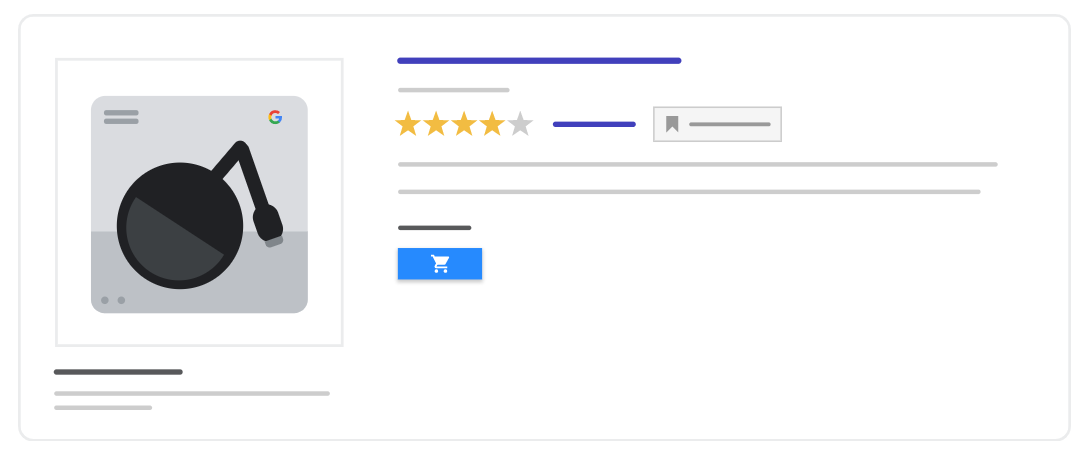
The Google Shopping experience is highly visual. It adds a visual touch to an otherwise text-heavy searching and shopping experience. Therefore, attractive product images play an essential role.
Because of that, it’s important to monitor and optimize product imagery and listings on your reseller's websites and to upload your own high-quality imagery via Manufacturer Center.
Ensure that images align with googles' rules and regulations to prevent penalties. Google recommends showing (as the main image) your product only on a solid white or transparent background.
If you want your products to be featured on Google Shopping, we advise following Google’s image guidelines from the start:
Recommended is to use 80 to 140 characters. Do not add promotional text and do not use CAPITAL LETTERS. Ensure all variant information in titles, including essential keywords for SEO purposes.
If a title does not include the following relevant information, Google can reject it: [product name] [brand] [specific information such as size, color, etc. + keywords].
Google gives you 140 characters for your title, so use those characters to provide the shopper with all relevant information to form a complete picture of your product.
The limit is 10,000 characters, but we recommend using 500 to 1500 characters. Describe your product clearly and accurately. Place the most crucial info at the beginning of your description to make sure shoppers can instantly read it on all devices and don't need to click on it to read more.
Include only relevant and complete information about your products. Tie benefits to your product features; ultimately, customers are buying results and experiences. Describing product benefits can make your products come to life.
If you want to learn more about writing product descriptions, read our blog about product descriptions that sell.
Your products' specified categories should help shoppers find your products easier in the search results. Being as specific as possible means your Google Shopping listings and ads are shown for the most relevant searches. This improves the customer journey and leads to more sales.
Google's automatic category assignment uses your feed attributes, such as titles and descriptions. So getting your product info accurate is also important for correct categorization. We recommend monitoring your product categories to ensure they are right.
You can manually override the automatic category assignment with the 'google_product_category’ attribute. Via Google's Manufacturer Center, you can add multiple product categories, but you need to separate them with a comma. Use ' > ' to separate various levels in a category.
The more detailed you include categories in your feed, the more accurately they can be classified and thus found by potential customers. It can be pretty challenging since the categories that your sales channels and marketplaces are using do not correspond to the Google Shopping categories.
Reviews are influential social proof and help your brand and products stand out on the Google Shopping shelf. A study even found that 94% of online purchases are made for products with an average star rating of 4 or 5 stars. (source: Sidecar)
As you can see in the image below, the first five Google Shopping results for HP Omen 15 inch show no product ratings. The organic results are not much better, with only one online store displaying reviews.
If you're displaying reviews, you are ahead of your competitors. Of course, it depends on if the ratings are positive. Research by PowerReviews and Northwestern University has shown that purchase probability peaks when a product’s average star rating is between 4.2 and 4.5. So if you can display a 4+ star rating, you stand out.
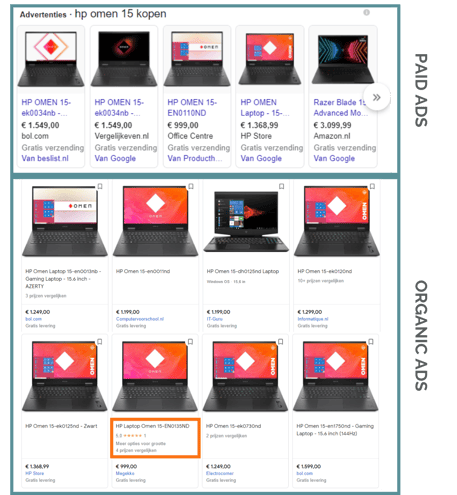
If you want to list your star rating to submit your product reviews to Google, you need to meet Googles' requirements and take action. So what do you need to do?
Monitoring and extracting Ratings & Reviews from your eCommerce channels might sound like a hell of a job but can be done automatically. You can download all verbatim reviews and additional info on all eCommerce channels via SiteLucent API.
When you want to start adding reviews to your Google Shopping listings but don't match Google's requirements yet, you can start with generating customer reviews.

If you (and your resellers) are not advertising your products on Google Shopping, you’re missing out because:
Okay, there are also some cons:
There are pros and cons to Google Shopping. Still, the tricks and tools to protect your brand online, the high conversion rates and low(er) costs show that it can certainly be worthwhile to delve into the Google Shopping possibilities and distinguish yourself from your competitors.
Product titles, descriptions, prices and availability, provided via data feeds to Google Shopping, should match with the information on the (retailers') landing page. Also, image URLs mostly refer to retailer websites. It is therefore essential to daily monitor your key resellers':
⌨️ Content: Accurate product titles, descriptions and imagery
🏷️ Prices
📦 Assortment & Stock Availability
"To measure is to know"! Monitoring the digital shelf can help you discover gaps and inconsistencies in product content daily, warn you when a product runs out of stock and measure your products' search rankings. From there, you can improve your presence and presentation online and exceed customers' expectations, not only on Google Shopping but on all eCommerce channels!
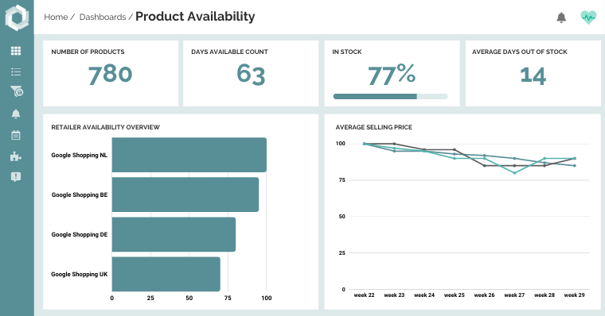
You can track Google Shopping offers with SiteLucent in the Netherlands, United Kingdom, Germany and 19 other countries.
What you can monitor daily:
Get in touch with our sales specialists if you have questions about or are interested in monitoring Google Shopping offers.
Optimizing product content on the digital shelf is essential for your brand to win. How do you keep the overview? and where do you start optimizing?
Selling your brand on marketplaces comes with challenges. Staying ahead of the competition and showing strong and keyword-optimized content is...
Digital Shelf optimization is a cross-functional path. Learn in this blog what roles can leverage digital shelf monitoring for your brand and how.
Be the first to receive digital shelf news, reports and insights.